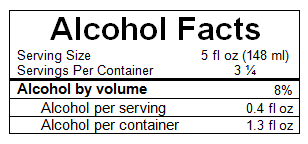Yes. Many vinegar production methods include a stage where alcohol has developed but vinegar, with its distinctive sour taste, has not. TTB regulates commercial vinegar production when there is a potential Federal excise tax liability as beverage alcohol under 26 U.S.C. 5001, 5041, or 5051 at any stage of production, including on raw materials used to make the vinegar.
Finished vinegar is not subject to alcohol beverage excise tax for any one of the following reasons:
- the manufacturing process makes it unsuitable for beverage use;
- the manufacturing process does not involve the production of alcohol; or
- none of the ingredients used to make the vinegar are subject to excise tax.
TTB does not regulate the following types of commercial vinegar production:
- vinegar made by diluting acetic acid;
- wine vinegar made from purchased wine that was made unfit for beverage use by the producing winery; or
- rice or malt vinegar made from purchased rice wine or beer that was made unfit for beverage use by the producing brewery.
Generally, all other vinegar production methods are regulated by TTB.
The TTB requirements to produce various types of finished vinegar are discussed below. Our website contains links to the TTB regulations cited on this page.
Wine vinegar
The regulations covering wine and wine vinegar production are in 27 CFR part 24 – Wine.
If you make vinegar from fresh fruit or juice, (this type of vinegar is classified as nonbeverage wine) you must:
- Qualify as a bonded wine cellar by filing an application and bond with TTB using Permits Online. See "Getting started in the Wine Industry" for more information. If you make only vinegar, you will not need the Federal Alcohol Administration Act wine producer's permit that is required for producers of beverage wine.
- Obtain approval for your formula indicating how you plan to make nonbeverage wine /vinegar.
- Keep records and file reports in accordance with 27 CFR part 24, subpart O. You will not be subject to excise tax if you make only finished vinegar according to your approved formula.
If you make vinegar from purchased beverage wine on which no tax has been paid, you must:
- File a bond (TTB Form 5510.2) with TTB to cover the tax on wine on hand, in transit, and unaccounted for until it is made into vinegar.
- Purchase the wine in bond from a bonded wine cellar or winery.
- In accordance with 27 CFR 24.291, keep records of wine received, wine used in the manufacture of vinegar, vinegar produced, and vinegar removed, and allow examination of your premises by TTB officers.
If you make vinegar from beverage wine on which the excise taxes are paid, TTB cannot refund the tax to you. Your operations will not be regulated by TTB.
If you make vinegar from wine that was made unfit for beverage use by the producing wine cellar or winery (therefore has no tax liability), then your operations are not regulated by TTB.
Malt or rice vinegar
The regulations covering production of beer or rice wine (saké) are in 27 CFR part 25 – Beer. Nonbeverage products made from beer or rice wine at breweries under approved formulas will not be subject to the Federal excise tax on beer when they are removed for sale.
If you produce your own beer or rice wine in the making of vinegar, you must:
If you purchase beer or rice wine that was made unfit for beverage use by the producing brewery, you may make that beer or rice wine into vinegar and your operations will not be regulated by TTB.
By law, beer or rice wine that is fit for beverage use cannot be transferred from the brewery to a manufacturer without payment of tax. If you make vinegar from beverage beer or rice wine on which the excise taxes are paid, TTB cannot refund the tax to you. Your operations will not be regulated by TTB.
Vinegar produced by distilling or the vaporizing process
If you want to produce vinegar by the "vaporizing process" (a process that involves the distillation of alcohol), see our information on qualifying as a distilled spirits plant under 27 CFR Part 19. See 27 CFR part 19 subpart W for rules on production of vinegar by the vaporizing process.
Manufacturer of nonbeverage products (MNBP)
If you buy taxpaid distilled spirits for vinegar production, TTB has a system for allowing drawback of most of the distilled spirits tax. See 27 CFR part 17 and our frequently asked questions to learn about the formula approval and claim process.
Vinegar production using specially denatured alcohol (SDA)
"Specially denatured" alcohol is a distilled spirits product with certain materials added that make it unfit for beverage use, but suitable for industrial uses. These denatured alcohol products may be shipped free of tax to persons who hold TTB permits as industrial alcohol users. See 27 CFR part 20 and "Information for Specially Denatured Spirits Applicants" for the permit, formula approval, and recordkeeping requirements for SDA users. Use Permits Online to apply.
Three formulas of SDA are authorized as a raw material for vinegar production. In two of them (SDA formulas 29 and 35-A), the denaturant is ethyl acetate, and in the other (SDA formula 18), the denaturant is vinegar. See 27 CFR 21.43, 21.56, and 21.62 for the specific formulas. Commercial strength vinegar made from SDA may contain trace amounts of residual alcohol, not to exceed 0.5 percent alcohol by volume, in the finished product (27 CFR 20.104).
Labeling of vinegar
Check with the Food and Drug Administration for vinegar labeling rules.
Other requirements
Check with your State alcohol regulatory agency to see if they regulate vinegar production.
For more information
If you have further questions, you may contact:




